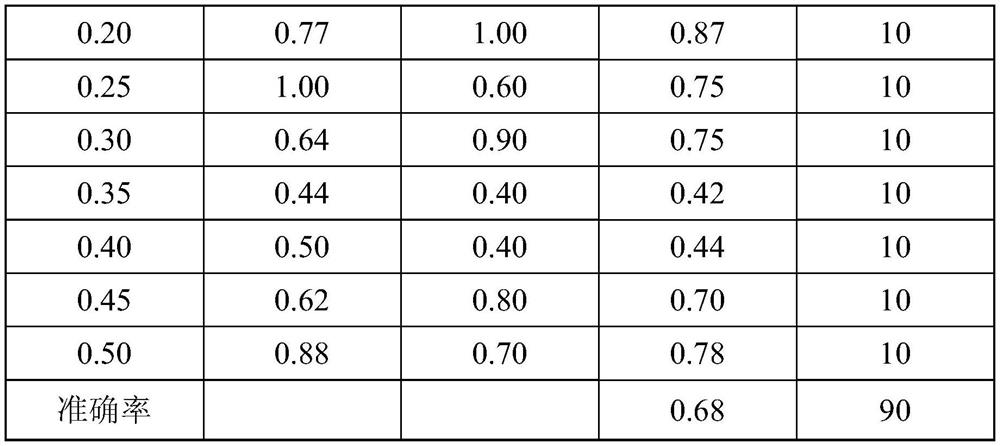A method for the determination of tea amino acid content based on colorimetric capsule image recognition
An image recognition and measurement method technology, applied in character and pattern recognition, material analysis by observing the impact on chemical indicators, instruments, etc., can solve the problems of high detection cost, difficult to popularize, complicated operation, etc., and achieve rapid batch production. The effect of detection, reducing instrument cost, and speeding up detection
- Summary
- Abstract
- Description
- Claims
- Application Information
AI Technical Summary
Problems solved by technology
Method used
Image
Examples
Embodiment 1
[0045] 1. Preparation technology of colorimetric capsules:
[0046] 1.1 Refer to GBT 8314-2013 Determination of the total amount of tea free amino acids to prepare buffer and color reagent, specifically:
[0047] The phosphate buffer step of preparation pH8.0 is as follows: Take by weighing 23.9g disodium hydrogen phosphate dodecahydrate (Na 2 HPO 4 12H 2 O), add water to dissolve and transfer to a 1L volumetric flask, set the volume to the mark, and shake well. Weigh potassium dihydrogen phosphate (KH 2 PO 4 ) 9.08g, add water to dissolve, transfer to a 1L volumetric flask, set the volume to the mark, and shake well. Take 95 mL of the above-mentioned disodium hydrogen phosphate solution and 5 mL of potassium dihydrogen phosphate solution and mix, and the pH of the mixture is 8.0.
[0048] Prepare 2% ninhydrin solution: weigh 2 g of ninhydrin (purity not less than 99%), add 50 mL of water and 80 mg of stannous chloride (SnCl 2 2H 2 O) Stir well. Add a small amount of ...
Embodiment 2
[0074] Black tea sample concentration prediction
[0075] Select 6 black tea samples: Wangfu tea premium grade, Wangfu tea first grade, Wanghai tea premium grade (canned), Wanghai tea premium grade (bag), Wanghai tea premium, Wanghai tea (bag).
[0076] The detection of samples is carried out according to the following steps:
[0077] 1. Refer to GBT 8314-2013 Determination of the total amount of free amino acids in tea to prepare the sample solution to be tested.
[0078] Specifically, weigh 3g (accurate to 0.001g) of ground tea sample in a 500mL conical flask (or prepare according to the proportion), add 450mL of boiling distilled water, immediately move it into a water bath, extract for 45min (shake once every 10min), Immediately after the leaching is completed, filter under reduced pressure while hot, and wash the residue with a small amount of hot distilled water for 2 to 3 times. Transfer the filtrate to a 500mL volumetric flask, dilute to the mark with water after coo...
Embodiment 3
[0093] Green tea sample concentration prediction
[0094] Select 6 green tea samples: Huangshan Maofeng Super Grade 1, Huangshan Maofeng Super Grade 2, Huangshan Maofeng Super Grade 3, Huangshan Maofeng Grade 1, Huangshan Maofeng Grade 2, and Huangshan Maofeng Grade 3.
[0095] The detection of samples is carried out according to the following steps:
[0096] 1. Refer to GBT 8314-2013 Determination of the total amount of free amino acids in tea to prepare the sample solution to be tested.
[0097] 2. Take capsule 1 and capsule 2 and melt at room temperature. Put the capsule 1 into the colorimetric measuring cup, add 1mL of the test liquid sample, and shake well. Add capsule 2, mix, shake well. Place in boiling water for 15 minutes, cool down, and finally add pure water to make up to the mark.
[0098] 3. Take pictures to collect the color image of the sample solution. The specific steps of image processing are: import the image into PS software, and do white balance proces...
PUM
| Property | Measurement | Unit |
|---|---|---|
| concentration | aaaaa | aaaaa |
Abstract
Description
Claims
Application Information
 Login to View More
Login to View More - R&D
- Intellectual Property
- Life Sciences
- Materials
- Tech Scout
- Unparalleled Data Quality
- Higher Quality Content
- 60% Fewer Hallucinations
Browse by: Latest US Patents, China's latest patents, Technical Efficacy Thesaurus, Application Domain, Technology Topic, Popular Technical Reports.
© 2025 PatSnap. All rights reserved.Legal|Privacy policy|Modern Slavery Act Transparency Statement|Sitemap|About US| Contact US: help@patsnap.com



